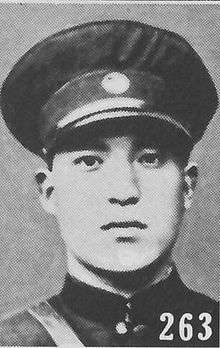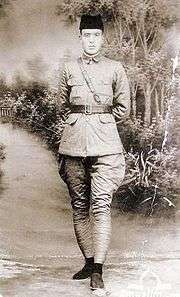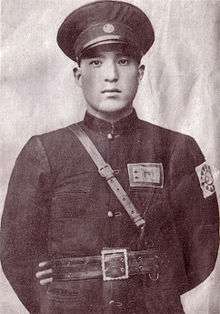Ma Zhongying
| Ma Zhongying | |
|---|---|
 Ma Zhongying | |
| Nickname(s) | Ga Ssu-ling ("Baby General" or "Little Commander")[1] or "Big Horse"[2] |
| Born |
馬仲英 1910 Linxia County, Gansu |
| Allegiance |
|
| Years of service | 1929-1934 |
| Rank | General |
| Unit | 36th Division (National Revolutionary Army) |
| Commands held | Chief of the 36th Division (National Revolutionary Army) |
| Battles/wars | Central Plains War, Kumul Rebellion, First Battle of Urumqi (1933), Soviet Invasion of Xinjiang, Battle of Kashgar (1934) |

Ma Zhongying, also Ma Chung-ying (simplified Chinese: 马仲英; traditional Chinese: 馬仲英; pinyin: Mǎ Zhòngyīng; Wade–Giles: Ma Chung-ying, Xiao'erjing: ﻣَﺎ ﺟْﻮ ىٍ ; c. 1910–1936?) was a Hui Chinese Muslim warlord during the Warlord era of China. Ma Zhongying's birth name was Ma Buying (simplified Chinese: 马步英; traditional Chinese: 馬步英; pinyin: Mǎ Bùyīng; Wade–Giles: Ma Pu-ying).[3] Zhongying was a warlord of Gansu province in China during the 1930s. His alliance with the Kuomintang (KMT) brought his predominately Chinese Muslim troops under the control of the KMT as the 36th Division (National Revolutionary Army); Zhongying was its commander. He was ordered to overthrow Jin Shuren, the governor of Xinjiang. After several victories over Provincial and White Russian forces, Ma Chung-ying attempted to expand his territory into southern Xinjiang by launching campaigns from his power base in Gansu, but was eventually stalled by Xinjiang warlord Sheng Shicai in 1934.[4]
The rise of Ma Zhongying
Ma Zhongying joined the Muslim militia in 1924 when he was 14 years old.[1] Ma Zhongying was involved in the rebellion against Feng Yuxiang's Guominjun forces in Gansu, and even fought against his own relatives such as the warlord Ma Lin, who had continued to serve the Guominjun.
Ma Zhongying seized Hezhou, and vanquished the army of his great-uncle Ma Lin; it was sent to recapture Hezhou from Ma Zhongying. Ma Zhongying was discharged bt his commander, his uncle Ma Ku-chang, for acting without orders to take Hezhou.[5] Ma Zhongying seized Gansu's capital from the Guominjun in April 1929 but was expelled and defeated by the Guominjun.[6]
Hui Muslims belonging to the Xidaotang sect and Tibetans in Taozhou were attacked by Ma Zhongying and his own Hui Muslim soldiers, causing an exodus of panicked Xidaotang Hui Muslims running away.[7]
Ma Zhongying's 1928 revolt led to a blaze which destroyed the Multicoloured Mosque[8]
Ma Zhongying attended the Whampoa Military Academy in Nanjing in 1929.[9][10][11]

Xinjiang during the 1930s
"He was like the rider on the pale horse, which appeared when the fourth seal was broken: 'And I looked, and behold a pale horse: and his name that sat on him was death, and Hell followed with him. And power was given unto them over the fourth part of the earth, to kill with the sword, and with hunger and death, and with the beasts of the earth.'"
Sven Hedin on Ma Zhongying[12]
Yulbars Khan asked the help of Ma Zhongying to overthrow Governor Jin Shuren, after Jin abolished the Kumul Khanate and set off the Kumul Rebellion. Ma fought in Xinjiang for a while, was wounded and returned to Gansu where he forced Mildred Cable, Francesca and Eva French to tend to his wounds.
Ma returned to Xinjiang in the summer of 1933.[13]
Ma and the 36th Division battled in the Kumul Rebellion the forces of Governor Jin and the white Russians. The KMT wanted Jin removed since he had signed without central approval a Soviet Union arms treaty.[14][15]
Ma's military actions were carried out by Hui officers and included atrocities toward Han and Uyghur civilians in Xinjiang during the fighting and conscripting Han and Uyghur forces for the front lines that were subject to heavy opposition cannon fire. The Soviets and Sheng Shicai claimed that Ma was being supported by the Japanese and using captured Japanese officers serving with his army. Despite this, Ma officially proclaimed his allegiance to the Chinese government in Nanjing.
Due to his severe abuse and brutality, the Turkis (Uyghurs) and Han Chinese hated the Hui officer who was in charge of Barkul- Ma Ying-piao, whom Ma Zhongying had put in place.[16]
The western traveller Peter Fleming reported that in 1935 Xinjiang was the only Chinese territory where Japanese agents were not active.[17]
After originally fighting against Ma Zhongying, the Han Chinese General Zhang Peiyuan and his Han Ili army defected to Ma Zhongying's side to fight against the provincial government and the Russians.
Ma Zhongying then battled against the Russians in the Soviet invasion of Xinjiang.

Personal character
Ma used the KMT Blue Sky with a White Sun banners and armbands in his military actions. He himself wore a KMT armband, and a 36th Division uniform to show that he was a legitimate representative of the Chinese government.[18]
His troops sang Chinese Muslim marching songs, Ma Zhongying himself had a harmonium with him, and he spent hours playing Muslim hymns on it. He had Mauser pistols. Ma Zhongying quoted as his models Genghis Khan, Napoleon, Hindenburg, and Zuo Zongtang.[19]
"He was a silly boy. He went mad. He murdered everyone."
Rewi Alley on Ma Zhongying[12]
Downfall
Sven Hedin's caravan of truck lorries encountered Ma forces while Ma and the 36th Division were retreating south from the Soviet Invasion of Xinjiang. While Sven was detained by Ma, he met General Ma Hushan, and Kemal Kaya Effendi. Ma's adjutant claimed to Hedin that Ma had the entire region of Tien-shan-nan-lu (southern Xinjiang) under his control and Sven could pass through safely without any trouble. Hedin did not believe this assertion.[20] Some of Ma's Tungan (Chinese speaking Muslim) troops attacked Hedin's expedition by shooting at their vehicles.[21]
In April 1934, after his forces had stormed Kashgar during the Battle of Kashgar (1934) Ma Zhongying himself arrived in the city and gave a speech at Id Kah Mosque in Kashgar, telling the Uyghurs to be loyal to the Chinese Kuomintang government at Nanjing.[22][23][24]
"Ma denounced Sheng Shicai as a Soviet puppet, and reaffirmed his alleigance to the Chinese government of Nanjing".[25]
During the Soviet invasion of Xinjiang Ma Zhongying played a major role in fighting the invaders but his troops had to withdraw again and again. The last defense line was set up around Khotan from where Ma finally fled into Soviet territory and was not seen again.
The book "Who's who in China" mistakenly claimed that Ma Zhongying came back from the Soviet Union in 1934 to Tianjin, China, and was residing there that year.[26][27]
British telegrams from British India in 1937 said that Tungans like Ma Zhongying and Ma Hushan had reached an agreement with the Soviets whom they had fought before, that since the Japanese had begun full scale warfare with China, that the Tungans, led by Ma Zhongying and Ma Hushan would help Chinese forces battle Japan, and that Ma Zhongying and Ma Hushan would return to Gansu, with Ma Zhongying being sent back to Gansu by the Soviets, who had been keeping him in Russia.[28][29]
Aftermath
In 1936, Zhang Guotao's forces crossed the Yellow River in attempt to expand the communist base into Xinjiang and make a direct connection with the USSR. Some sources allege that Ma Zhongying enlisted in the Red Army and became a high-ranking special adviser to the proposed Soviet force that was planning to take action according to Zhang Guotao's forces. Ma Zhongying's tasks were, reportedly, to advise Soviets on the situation in Xinjiang and to help the Soviets negotiate with his cousins Ma Bufang, Ma Hongbin, and their families so that these warlords would not hinder Zhang Guotao's forces. However, the Soviet plan did not materialize because Zhang Guotao's communist force was met, on orders from Chiang Kai-shek, and rapidly annihilated by the united 100,000-soldier Ma clique Kuomintang Army (Ma Bufang forces from Qinghai, a remnant of Ma Zhongying forces from Gansu, and Ma Hongkui and Ma Hongbin forces from Ningxia). Zhang Guotao's considerable 21,600-soldier Fourth Red Army force (in comparison with 8,000-soldier First Red Army force, led by Mao Zedong) collapsed much faster than the Soviets had expected, and not one of Chinese communist soldiers reached Xinjiang alive.
Nothing more was heard from Ma Zhongying after 1936. There are at least five stories of Ma's end:
- Ma was killed in a crash prior to World War II.
- Ma was executed after being taken to Moscow in 1936.
- Ma was imprisoned at a labor camp and later executed during the Great Purge of the Army in 1937–1938.
- Some writers, such as Red Army General Konstantin Rokossovsky, allege that Ma was first arrested during the Great Purge but was later released and participated in the Great Patriotic War.
- According to Sheng Shicai's memoir, Sinkiang: Pawn or Pivot? (Michigan University Press, 1958) Ma, together with all his staff, was killed by Stalin in Moscow during the summer or spring of 1937.
References
- 1 2 Andrew D. W. Forbes (1986). Warlords and Muslims in Chinese Central Asia: a political history of Republican Sinkiang 1911-1949. Cambridge, England: CUP Archive. p. 52. ISBN 0-521-25514-7.
- ↑ Hedin, Sven, The Flight of Big Horse, New York: E.P. Dutton & Co., 1936.
- ↑ James A. Millward (2007). Eurasian crossroads: a history of Xinjiang. Columbia University Press. p. 193. ISBN 0-231-13924-1. Retrieved 2010-06-28.
- ↑ Who's who in China; biographies of Chinese leaders. Shanghai: THE CHINA WEEKLY REVIEW. 1936. p. 184. Retrieved 24 April 2014.
- ↑ Andrew D. W. Forbes (1986). Warlords and Muslims in Chinese Central Asia: a political history of Republican Sinkiang 1911-1949. Cambridge, England: CUP Archive. p. 334. ISBN 0-521-25514-7. Retrieved 2010-06-28.
- ↑ Association for Asian Studies. Southeast Conference (1979). Annals, Volumes 1-5. The Conference. p. 51. Retrieved 24 April 2014.
- ↑ Jonathan Neaman Lipman (1 July 1998). Familiar strangers: a history of Muslims in Northwest China. University of Washington Press. pp. 196–197. ISBN 978-0-295-80055-4.
- ↑ Michael Dillon (1999). China's Muslim Hui Community: Migration, Settlement and Sects. Psychology Press. pp. 119–. ISBN 978-0-7007-1026-3.
- ↑ James A. Millward (2007). Eurasian crossroads: a history of Xinjiang. New York: Columbia University Press. p. 193. ISBN 978-0-231-13924-3.
- ↑ Michael Dillon (1999). China's Muslim Hui community: migration, settlement and sects. Surrey: Curzon Press. p. 89. ISBN 978-0-7007-1026-3.
- ↑ Christian Tyler (2003). Wild West China: the taming of Xinjiang. New Brunswick, NJ: Rutgers University Press. p. 98. ISBN 978-0-8135-3533-3.
- 1 2 Andrew D. W. Forbes (1986). Warlords and Muslims in Chinese Central Asia: a political history of Republican Sinkiang 1911-1949. Cambridge, England: CUP Archive. p. 97. ISBN 0-521-25514-7. Retrieved 2010-06-28.
- ↑ Ji, Xiaofeng; Shen, Youyi; 末次研究所 (Beijing, China), Suetsugu Kenkyūjo (Peking, China), 厦門大學. 圖書館 (1998). Zhonghua Minguo shi shi liao wai bian: qian Riben Mozi yan jiu suo qing bao zi liao : Ying wen shi liao. Volume 25 of Zhonghua Min Guo Shi Shi Liao Wai Bian: Qian Riben Moci Yan Jiu Suo Qing Bao Zi Liao : Ying Wen Shi Liao, 末次 研究所 (Beijing, China)
Volume 25 of Chung-hua Min Kuo Shih Shih Liao Wai Pien: Chʻien Jih-pen Mo-tzʻu Yen Chiu So Chʻing Pao Tzu Liao : Ying Wen Shih Liao, Suetsugu Kenkyūjo (Beijing, China) (reprint ed.). kuang-hsi shih fan ta hsüeh chʻu pan she. p. 278. Retrieved 24 April 2014. Cite uses deprecated parameter
|coauthors=(help); line feed character in|volume=at position 143 (help) - ↑ Andrew D. W. Forbes (1986). Warlords and Muslims in Chinese Central Asia: a political history of Republican Sinkiang 1911-1949. Cambridge, England: CUP Archive. pp. 98, 106. ISBN 0-521-25514-7. Retrieved 2010-06-28.
- ↑ Ai-ch'ên Wu, Aichen Wu (1940). Turkistan tumult. Methuen: Methuen. pp. 71, 232. ISBN 978-0-19-583839-8. Retrieved 2010-06-28.
- ↑ Sven Anders Hedin (1936). The Flight of "Big Horse": The Trail of War in Central Asia. Dutton. p. 38.
- ↑ Peter Fleming (1999). News from Tartary: A Journey from Peking to Kashmir. Evanston Illinois: Northwestern University Press. p. 262. ISBN 0-8101-6071-4.
- ↑ Andrew D. W. Forbes (1986). Warlords and Muslims in Chinese Central Asia: a political history of Republican Sinkiang 1911-1949. Cambridge, England: CUP Archive. p. 108. ISBN 0-521-25514-7. Retrieved 2010-06-28.
- ↑ Christian Tyler (2004). Wild West China: the taming of Xinjiang. New Brunswick, New Jersey: Rutgers University Press. p. 109. ISBN 0-8135-3533-6. Retrieved 2010-06-28.
- ↑ Sven Anders Hedin (1936). The flight of "Big Horse": the trail of war in Central Asia. E. P. Dutton and co., inc. p. 84. Retrieved 18 Jan 2012.
amusing to listen to his outspoken but untruthful conversation... he said ...The whole country in that quarter, Tien-shan-nan-lu, acknowledged the rule of General Ma Chung-yin. General Ma Yung-chu had ten thousand cavalry under his orders, and the total strength of the Tungan cavalry was twice that number
- ↑ Sven Anders Hedin (1940). The wandering lake. Routledge. p. 24. Retrieved 18 Jan 2012.
their object had been to cut us off. A month had not passed since our motor convoy had been cut off by Tungan cavalry , who had fired on it with their carbines. Were we now to be stopped and fired at on the river too ? They might be marauders from Big Horse's broken army, out looting, and
- ↑ S. Frederick Starr (2004). Xinjiang: China's Muslim borderland. M.E. Sharpe. p. 79. ISBN 0-7656-1318-2. Retrieved 2010-06-28.
- ↑ James A. Millward (2007). Eurasian crossroads: a history of Xinjiang. Columbia University Press. p. 200. ISBN 0-231-13924-1. Retrieved 2010-06-28.
- ↑ Andrew D. W. Forbes (1986). Warlords and Muslims in Chinese Central Asia: a political history of Republican Sinkiang 1911-1949. Cambridge, England: CUP Archive. p. 124. ISBN 0-521-25514-7. Retrieved 2010-06-28.
- ↑ Andrew D. W. Forbes (1986). Warlords and Muslims in Chinese Central Asia: a political history of Republican Sinkiang 1911-1949. Cambridge, England: CUP Archive. p. 124. ISBN 0-521-25514-7. Retrieved 2010-06-28.
- ↑ China weekly review (1936). Who's who in China, Volume 3, Part 2. China weekly review. p. 184. Retrieved 2011-06-06.
- ↑ Who's who in China (Biographies of Chinese). Volume 4 of Who's who in China. 1973. p. 184. Retrieved 2011-06-06.
- ↑ The Silk Road. Taylor & Francis. 1973. p. 308. Retrieved 18 Jan 2012.
Sino-Japanese hostilities,. . . and the Tungan military leaders. . . are now preparing to support the Chinese forces. . .General Ma Chung-yin. . . is proceeding to Kansu to assist the Chinese . . .His half-brother, General Ma Ho-san, who recently fled to Calbutta when the Tungan rebellion collapsed, has also been invited to assist the Chinese. His departure for Kansu is regarded as a certainty. . .The other Tungan general who is mentioned in the telegram from Delhi, the cavalry commander Ma Ho-san, who is not Ma Chung-yin's brother, though probably a relative, is also mentioned in Big Horse's Flight.
- ↑ Sven Hedin (2009). The Silk Road: Ten Thousand Miles Through Central Asia (reprint, illustrated ed.). I. B. Tauris. p. 308. ISBN 1-84511-898-7. Retrieved 18 Jan 2012.
The other Tungan general who is mentioned in the telegram from Delhi, the cavalry commander Ma Ho-san, who is not Ma Chung-yin's brother, though probably a relative, is also mentioned in Big Horse's Flight.
| Wikiquote has quotations related to: Ma Zhongying |
| Wikimedia Commons has media related to Ma Zhongying. |
- "The Soviets in Xinjiang (1911--1949)" by Mark Dickens. USA, 1990
- "Sinkiang: Pawn or Pivot? " by Allen Whiting and Sheng Shih- Ts'ai. Michigan State University Press, USA, 1958